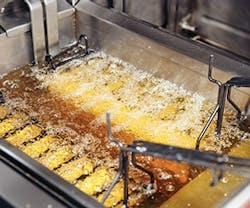What happens to your old batch of cooking oil when it has fried its last fry? That yellow oil can boost your facility’s green credibility and may even be able to turn a profit for you.
Keep cooking oil out of the landfill and sewers and put it to work again with a recycling program.
Why Recycle?
Cooking oil has been recycled for years into goods like animal feed and cosmetics, but new recycling initiatives offer a greener second life, explains Rory Gaunt, CEO of Lifecycle Renewables, a recycler that hyper-refines used oil into renewable diesel fuel. Biodiesel, which is created by chemically altering the properties of fats, is another option for using your discarded oil to green your fleet. No. 2 heating oil can also be replaced with products made from cooking oil.
In addition to reducing the volume of what you send to the landfill, the oil itself can be worth money.
“Vendors will give a price for service based on what the market says the oil is worth,” Gaunt explains. “Until about seven years ago, customers paid about $1 per gallon to have the oil removed. Since then, the market swung roughly $2 the other way, meaning that vendors would pay customers up to $1 per gallon for their old oil. Now the value has gone back down again. Know the commodity value of yellow grease so you can understand where the value is and how that impacts service costs.”
How to Set Up Your Program
Develop a service agreement with your vendor that accounts for these seven considerations.
1) How much oil are you producing? Know how much you’ll use in a week or month and how many locations on your property need recycling. “You don’t want employees carrying oil too far to store it. Large institutions like university campuses typically have multiple service locations where the waste oil is presented for pickup,” explains Gaunt.
2) How big should your oil container be? Vendors can offer multiple sizes – for example, Gaunt’s average customer produces about 12 gallons per week and has a storage capacity of about 100 gallons split between two barrels. To find the right size for your facility, consider how much space you can realistically dedicate to storing oil, Gaunt suggests.
“Some sites don’t have space to put down a 300-gallon container, which has a footprint of about 3.5 by 5 feet. However, if you have something smaller on site, that raises concerns with traffic – how many times will a truck come for pickup?” says Gaunt. “That frequency also affects the cost to the service provider.”
3) How often should your container be picked up? Your rate of pickup and the size of your container affect each other, notes John Remstedt, Owner and President of Grease Masters, which provides cooking oil recycling and grease trap cleaning. Remstedt recommends having your oil container picked up at least every two months to discourage theft.
“You don’t want the oil sitting out any longer because there is a huge grease theft problem,” Remstedt explains. “It’s a tradable commodity. We provide locking containers and people will come out with saws for them.”
4) How cold is your area in the winter? Your oil has to be flowable when it’s picked up, so facilities in areas with harsh winters will have to heat their containers during colder months, Remstedt says. Some vendors offer containers with a built-in heating element that can keep oil from solidifying.
5) How clean is your oil? Filter your oil instead of pouring it directly into the containers, Remstedt recommends – your rebate will be smaller if the vendor has to remove a deposit of accumulated food waste on your behalf.
Also be careful not to contaminate it with the wrong grease sources, Remstedt says: “A lot of people will put the grease trap waste in the oil container because it says ‘grease.’ A grease trap is raw sewage, not used cooking oil, so now the whole container is contaminated.”
6) How will you safeguard against spills? Most spills are created by customers, but a reputable vendor should keep the area around the disposal container clean, Remstedt says.
7) What other services are available? Many vendors offer additional services that can be bundled with oil recycling to lower costs, Gaunt says. Consider asking your prospective vendor about adding cleaning and maintenance for exhaust hoods, grease traps, drains and kitchen equipment.
Janelle Penny [email protected] is Senior Editor of BUILDINGS.
About the Author
Janelle Penny
Editor-in-Chief at BUILDINGS
Janelle Penny has been with BUILDINGS since 2010. She is a two-time FOLIO: Eddie award winner who aims to deliver practical, actionable content for building owners and facilities professionals.

